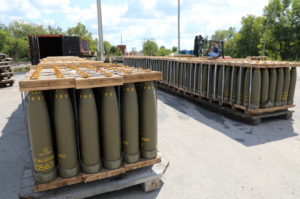The Biden administration’s emergency supplemental spending request includes $3.1 billion to boost 155mm artillery ammunition production, which a top Army official has said is needed to ensure the service can meet its aim to build 100,000 such rounds per month by late 2025.
“Congress, to their credit, has already been very generous and they’ve really given us a path to 75,000-80,000 [155mm rounds] per month. We need this additional funding to get over 100,000 [rounds] a month,” Doug Bush, the Army’s acquisition chief, told reporters on Tuesday.

Bill LaPlante, the Pentagon’s top acquisition official, confirmed in September the Army’s goal is to build 100,000 155mm rounds per month, a nearly fourfold increase from current capacity, as the service works to replenish its own stockpiles and continue supporting requirements for international partners such as Ukraine and Israel (Defense Daily, Sept. 15).
Last month, the Biden administration rolled out its $106 billion supplemental spending request with $61.4 billion to continue supporting Ukraine in its fight against Russia’s ongoing invasion, $14.3 billion in assistance for Israel following Hamas’ incursion on Oct. 7 and as the country pursues a ground invasion of Gaza, $7.2 billion in Foreign Military Financing grants, $4 billion to support partners in the Indo-Pacific region and $3.4 billion to bolster submarine industrial base efforts (Defense Daily, Oct. 20).
The White House has noted that $50 billion within the request would be invested into the U.S. defense industrial base.
“This important legislation is needed for the Army to be able to meet the growing challenges we face today and in the future,” Bush said. “It will strengthen our industrial base to ensure we can supply our defense needs, as well as serving as the arsenal of democracy for our allies trying to defend themselves against aggressors. Importantly, the lion’s share of this funding is being invested here in the United States.”
Bush noted the $3.1 billion spread across the bill for 155mm artillery ammunition, which the U.S. has been providing to Ukraine and Israel, is split between $1.48 billion in projects to increase production capacity and $1.63 billion for buying artillery shells and charges.
For artillery shell procurement, the supplemental request included $850 million to buy 600,000 155mm artillery shells and $700 million to buy two million charges to shoot the shells.
To boost 155mm ammo production, the supplemental request supports projects ranging from $650 million to fund construction of a domestic TNT production facility at Radford Army Ammunition Plant in Virginia to $600 million to “almost triple” the amount of IMX-104 explosives that can be made at the Holston Army Ammunition Plant in Tennessee.
“There’s currently no production of TNT anywhere in the United States. We rely on allies. This would bring that important explosive production back to the United States,” Bush said of the Radford project.
The supplemental request also includes $93 million to reestablish M6 propellant production at the Radford plant, $80 million related to production of 155mm ammo metal parts at Scranton Army Ammunition Plant in Pennsylvania, $21 million for 155mm ammo metal parts production at a private facility in Hanover, Pennsylvania and $14 million to recommission a black powder production line in Louisiana.
“We’re not just building more capacity, we’re modernizing at the same time,” Bush told reporters.
Bush noted the Army is currently producing 28,000 155mm ammo rounds per month right now and is on the path to 36,000 in early 2024, around 60,000 by the end of FY ‘25, then 70,000 to 80,000 by early 2025 and finally reaching 100,000 per month by late 2025, if Congress appropriates the $3.1 billion in supplemental funding.
Beyond 155mm artillery round projects, Bush said the supplemental also supports $755 million to increase Patriot missile production capacity from 500 a year today to more than 650 in the future, $100 million for for “numerous upgrades” at the Lake City Army Ammunition Plant in Missouri “to make it safer and increase production rates,” $72 million to build a new wastewater treatment plant at Lake City and $25 million to double tank ammunition production capacity up to 20,000 a year.
Bush said the supplemental funding measures to date, which has included efforts to Ukraine support, has allowed the Army to move faster on its 15-year, likely $16 billion organic industrial base modernization plan (Defense Daily, Feb. 1 2022).
“With a lot of encouragement from Congress, to their credit, we’ve done a lot of work on having a plan to increase production and improve safety conditions at our government plants. Through the Ukraine supplementals, we’ve been able to do that plan at a much faster rate,” Bush said.
“So the fact that we had those plans ready to go has made a huge difference. So, yes, we’ve probably brought down many years off of that original plan because we’ve been able to get the resources much faster through supplemental funding and a broader recognition that we need to improve our organic industrial base equipment. So it’s really allowed us to go a lot faster than we would have otherwise.”